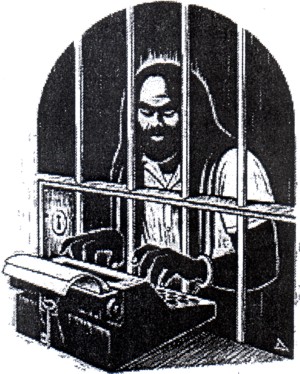PHILADELPHIA, December 9, 2013 – On the 32nd year of Mumia Abu-Jamal’s wrongful incarceration, his supporters will hold a press conference at noon in front of the District Attorney’s Office at 3 South Penn Square to outline the case for Abu-Jamal’s innocence, call for his immediate release, and announce the launch of the Campaign to Bring Mumia Home. At 6PM they will hold an organizer’s meeting at the Asian Arts Initiative. These activities will culminate a weekend of events in Philadelphia and New York including forums on the case and its broader significance led by High School and college activists on Saturday, December 7: in Philadelphia, Youth on the Move will be held at the Asian Arts Initiative from 11-2PM; in New York, the We Want Freedom Scholarship launch will be held at Hostos Community College in the Bronx, Room B-501 from 1-4PM.
“For the last 32 years, the Philadelphia courts, government officials, and local journalists have succumbed to the pressures of the Fraternal Order of Police (FOP) and abandoned the pursuit of truth in the case of this world-renowned journalist who was racially profiled and targeted for his political affiliations by a Philadelphia police department with a long history of brutality and corruption,“ said Heidi Boghosian, Executive Director of the National Lawyers Guild.
In 2011, Abu-Jamal’s death sentence was declared unconstitutional and commuted to life without parole for allegedly murdering Philadelphia police officer Daniel Faulkner in 1981. Despite clear evidence of police perjury and evidence tampering to obtain a conviction and in spite of compelling evidence of innocence, for 32 years, Abu Jamal has been denied basic rights.
“The lengths to which the Philadelphia police department and the prosecutor, Joe McGill, went to falsify evidence in this case strongly point to Abu-Jamal’s innocence,” says Dr. Suzanne Ross of New York, a veteran advocate in the case.
Crime scene ballistics evidence disproves the theory presented in court by the prosecution. The implausibility of the prosecution’s theory is corroborated by the first photos taken of the crime-scene. These photos were taken by Philadelphia freelance photographer Pedro P. Polakoff and discovered in 2006 by Dr. Michael Schiffman of Heidelberg University in Germany.
The prosecution’s theory posits that Abu-Jamal, who came running from a parking lot, shot Officer Faulkner in the back, that the officer swung around as he was falling and then managed to shoot Abu-Jamal in the chest. The prosecution further argued that Abu-Jamal stood over the prone officer and shot several bullets directly into the ground at Officer Faulkner and that one of those bullets hit and killed the officer execution style.
However, the sidewalk where the officer laid dead, pictured in nine of the Polakoff photographs, shows no bullet marks on the ground – even though according to the testimony of the three core prosecution witnesses such bullet marks would have had to have been there. This strongly suggests that these witnesses were coached or coerced.
The prosecution’s theory is also called into question because police failed to perform routine gun-powder tests on the gun or Abu-Jamal’s hands that could have proved that he did not shoot a gun that evening.
Contrary to what the prosecution argued at trial, crime scene ballistics evidence suggests that Officer Faulkner was shot from the direction of the passenger’s seat of the Volkswagen he had stopped, not from the direction of the parking lot from where Abu-Jamal came running. According to crime investigations reporter Patrick O’Conner, “One of the most important and least known facts of this case is the existence of a fourth person at the crime scene, Kenneth Freeman, the person believed to have been the passenger in the Volkswagen. Within hours of the shooting, a driver’s license application found in Officer Faulkner’s shirt pocket led the police to Freeman. Yet Freeman’s presence at the scene was concealed, first by Inspector Alfonso Giordano and later, at trial, by Prosecutor Joe McGill.”
The Polakoff photos also point to the possible presence of a fourth person at the crime scene: Officer Faulkner’s hat is pictured resting on top of the Volkswagen on the side of the passenger’s seat, suggesting that he may have had a conversation with the passenger. However, the dramatic photograph that made it into the newspapers was one staged by police at the crime scene to elicit an emotional reaction to the news of a fallen police officer in Philadelphia. In that police photograph, Officer Faulkner’s hat migrated from the top of the Volkswagen above the passenger’s seat where it had been on Polakoff’s first photographs to the sidewalk next to the long trail of Officer Faulkner’s blood.
The Polakoff photographs also reveal that officer James Forbes, who testified in court that he had properly handled the guns allegedly retrieved at the crime scene, is holding the guns with his bare hands, destroying all potentially significant fingerprints. This kind of evidence tampering was endemic in the police department. Fully a third of the 35 officers involved in the Abu-Jamal case, including the top officer at the crime scene, Inspector Alfonzo Giordano, were later convicted of rank corruption, extortion and tampering with evidence to obtain convictions in other cases.
The Polakoff photos also discredit one of the prosecution’s key witnesses, Robert Chobert, who testified in court that he saw what happened at close range that night because his taxi was parked immediately behind officer Faulkner’s car. Yet, contrary to his testimony, on the three Polakoff photos showing the alleged location of the cab, the space is actually completely empty.
According to Dr. Johanna Fernandez, Professor of History at Baruch College, “those whose careers would be destroyed if the truth surfaced in this case argue that the failure of the appellate process to grant Abu-Jamal relief is proof of his guilt. However, as was recently demonstrated in the case of Herman Wallace of the Angola 3 case, the appellate system in the United States very often fails the defendants.” “The problem with the appellate process,” adds Dr. Mark Taylor, Professor of Theology at Princeton Theological Seminary, “is that following a series of regressive, states rights laws passed in the 1990s, such as the Anti-Terrorism and Effective Death Penalty act of 1996, appellate judges are forced to accept as ‘fact’ tampered evidence collected by the police and established by lower courts,”
“We urge people of conscience in Philadelphia to call on the Philadelphia DA and the Governor of Pennsylvania to release Mumia Abu-Jamal, and bring Philadelphia’s native son home,” says Dr. Fernandez.

